Back To Basics: The Current State of Fitness in the UK
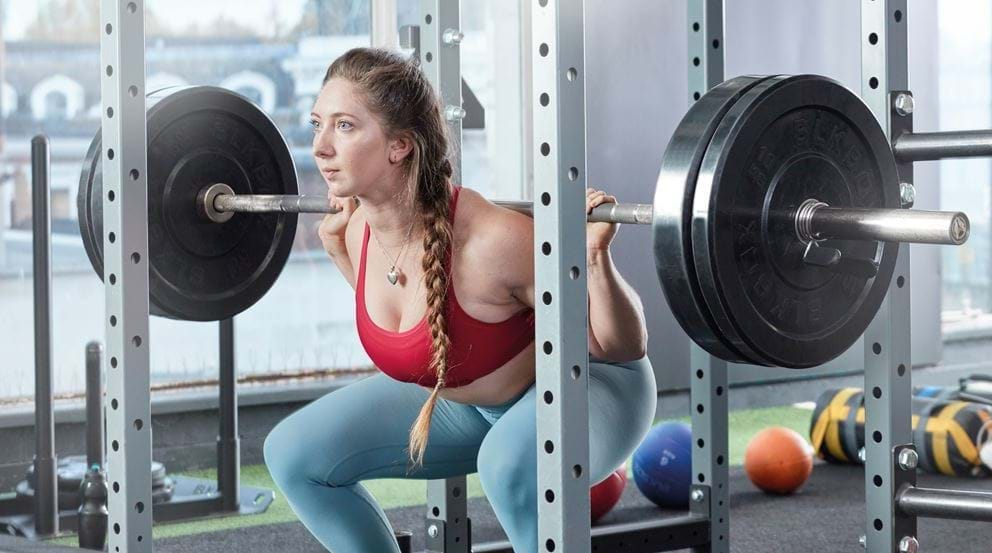
In this year's edition of the annual PureGym UK Fitness Report, we revealed that 34% of the UK population do not exercise on a weekly basis, and almost a quarter (23%) don't view themselves as healthy.
Modern lifestyles are more sedentary than ever thanks to a culmination of factors, from an increase in office-based jobs to technology that connects us with friends, restaurants, and taxis at the tap of a screen. While these innovations add to our lives, a sedentary lifestyle increases our risk of disease and mortality.
Being physically fit reduces these risks, but also allows us to move with ease in our day-to-day activities. Physical fitness is more than just strength -- it's no good being able to bench press 200kg if you can't walk up a flight of stairs without getting out of breath, or pick something up off the floor without injuring your back.
We surveyed over 2,000 people (aged 16+) in the UK to find out how many of us have the basic strength, mobility, and endurance needed to go about our daily lives with ease. To do this, we worked with Phil Carpenter, a former competitive athlete who worked as a Royal Army physical training instructor for 15 years and now offers advanced personal training at PureGym Portsmouth, to come up with several core basic tests of strength, mobility, and endurance.
Once the results were in, we spoke with Phil to reveal why we struggle with certain aspects of these basic fitness principles, and what we can do to improve them.
Phil also analysed over 100 social media videos on TikTok and Instagram of people completing basic strength exercises (tricep dips, squats, and push ups) to reveal our common form errors, and how to avoid them when working out.
What is covered:
- Key findings
- What is physical fitness, and what are the benefits?
- How capable are we of performing basic strength exercises?
- How capable are we of performing basic cardio exercise?
- How good is our basic flexibility?
- How does this translate to our day-to-day mobility?
- What exactly does all this mean?
- How can we improve our basic levels of fitness?
Key findings
1 in 3 people (34%) are unable to complete a single tricep dip/chair lift
Over a quarter of the population (27%) are unable to complete a single squat
Nearly 1 in 3 (32%) people living in the UK are unable to complete a single push up
38% of the population feel they would be unable to complete a 1.5-mile run
Only 4 in 10 of the UK population (41%) can successfully touch their toes
More than two thirds of the UK population (68%) struggle with stiff or tight muscles
The majority also struggle with poor flexibility (69%), back pain or aches (71%) and feeling fatigued (72%)
More than two thirds (70%) of people aged under 34 years old, struggle with walking up the stairs, and get out of breath when doing so
Across the board, the results indicate that there's a significant proportion of the UK population that struggle with basic fitness levels that would make everyday life that little bit easier. While those aged 35-44 generally tend to achieve average scores (i.e., acceptable fitness levels), the same cannot be said for individuals younger and older than this age group.
Phil explains: "For those aged 44 and above, there are many reasons fitness may be below average. This age group may be more likely to have busy households with multiple children, or busy and stressful jobs, which can make finding time to work out more difficult. As we get older, we're also more likely to experience wear and tear on the joints and muscles, injuries, and other physical ailments that can impact our strength, endurance, and mobility.
For those under 35, there can be several lifestyle and cultural factors at play. Younger generations are less likely to have as much physical education in school and physical activities after school, than older generations, meaning a lot of those 35 and younger reached or are reaching adulthood with lower levels of fitness, and with less awareness of the benefits of an active lifestyle. Meanwhile, there are more recreational activities that do not involve movement nowadays, and jobs are more sedentary too."
But what is physical fitness, and what are the benefits?
Physical fitness is described as the ability to carry out everyday activities without unnecessary fatigue. This requires the heart and lungs, muscles, and soft/skeletal tissues to work together to provide strength, mobility, and endurance to the body.
Being physically fit isn't just an argument for being better at sports, or making everyday life easier, however. It has extremely important non-performance-based benefits too, contributing to a healthier lifestyle that means you're less at risk of developing long term health problems. Dozens of studies show that the risk of cardiovascular disease, thromboembolic stroke, hypertension, type 2 diabetes mellitus, osteoporosis, obesity, colon cancer, breast cancer, anxiety and depression all decrease with an increase in physical activity.
So, how capable are we of performing basic strength exercises?
When we talk about muscular strength, we're really talking about the ability to lift or move objects. Phil explains that "strength is key to performing everyday activities with ease, and as we age strength training can also help to build muscle mass which protects the joints and improves balance and stability. It also builds and preserves bone density, reducing the risk of falls and injuries as we age, and allowing us to maintain independence for longer."
We surveyed the nation to assess our levels of strength, by seeing how many could complete the following basic exercises:
- Tricep dips
- Squats
- Push ups
Tricep Dips
When asked how many tricep dips they could complete until failure, 1 in 3 people (34%) stated that they are not able to complete a single repetition of the movement. Of those that can perform the movement, people can do 6 reps on average (according to our study) - which is considered the amount that a 60-year-old or above should be able to do. Those who do not exercise were only able to complete 2 reps on average.
When questioned on how comfortable they felt performing a tricep dip, nearly half (43%) stated that they didn't feel comfortable at all, compared with just 29% who did feel comfortable.
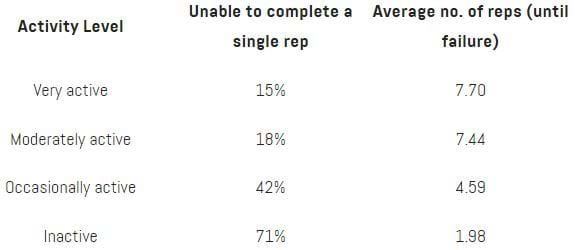
Table showing how many individuals that deem themselves very active, moderately active, occasionally active or inactive are unable to complete a single tricep dip, and the average number of reps for each
Common mistakes and how to avoid them:
- A lack of strength can lead to leaning forward during a tricep dip, meaning you're exercising your chest rather than your triceps. If if you find this happening , reduce the number of reps and focus on remaining upright without any forward lean, instead of how many reps you can complete. Using resistance bands or an appropriate gym machine to complete assisted tricep dips, can be a great way to build strength.
- Using too much, or too little, of your range of motion. Dipping too low can put excessive strain on your shoulders, leading to possible injury. Conversely, not using your full range of motion means you're not activating all three of the tricep heads. Trying to get your shoulders parallel with your elbows will help to achieve this.
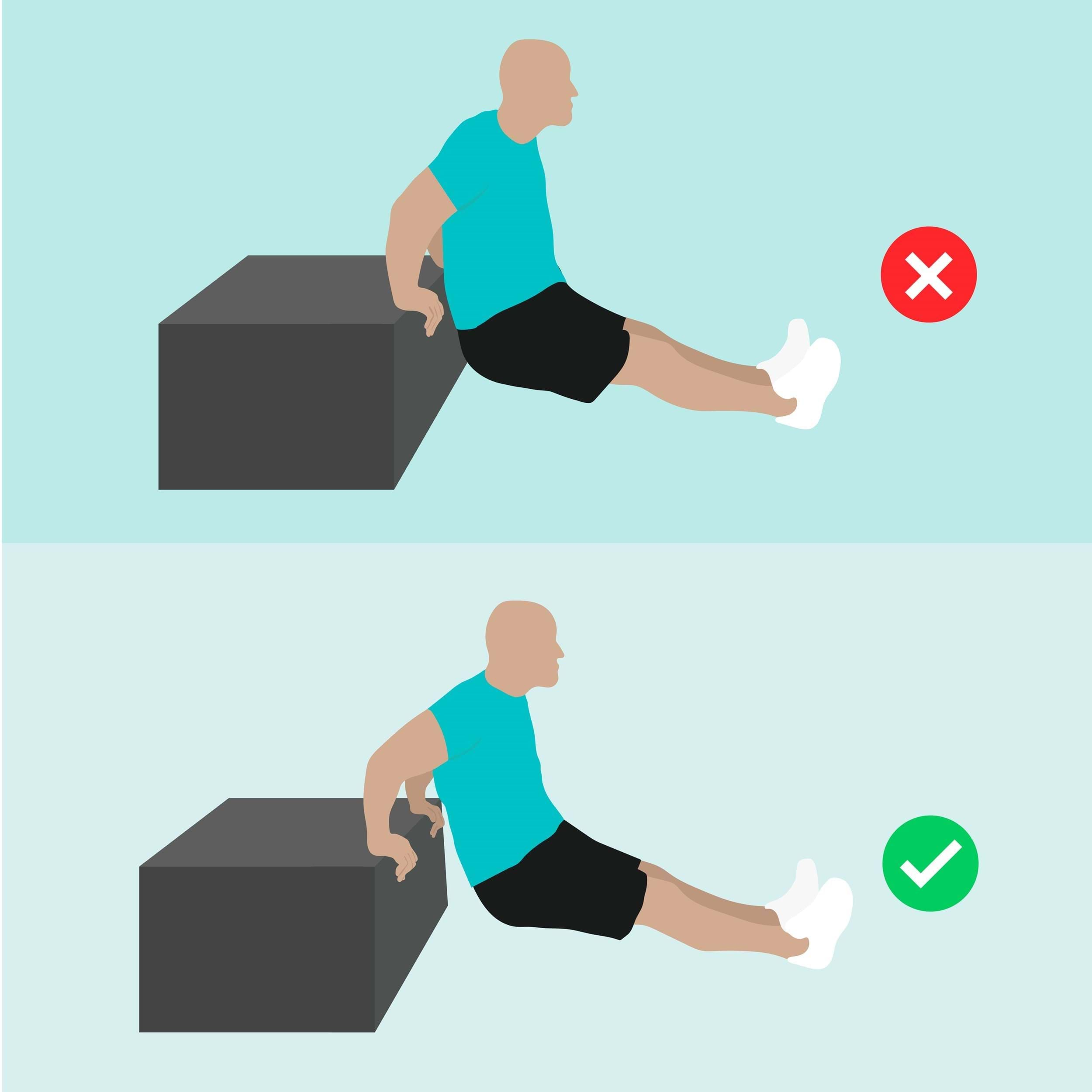
Squats
When asked how many squats they could complete until failure, over a quarter of the population (27%) stated that they would be unable to complete a single repetition of the movement, increasing to 64% of those who are inactive. Of those who could, the average number of reps they were able to do was just 10 - to put this into context, this many reps would be classed as 'poor' for a man aged over 56 years old.
Meanwhile, more than half of the population (58%) are only able to complete a maximum of 5 squats. Interestingly, only being able to complete 5 squats is considered 'very poor' for a man aged over 65, or a woman aged over 46.
When questioned on how comfortable they felt performing a squat, the results are fairly even, with 39% stating they felt comfortable performing the movement, and 36% saying they didn't.
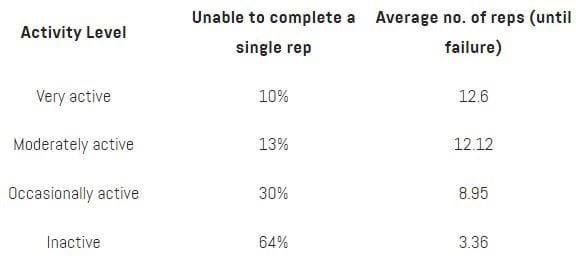
Table showing how many individuals that deem themselves very active, moderately active, occasionally active or inactive are unable to complete a single squat, and the average number of reps for each
Common mistakes and how to avoid them:
- Often a lack of mobility in the ankle can really impact your ability to squat correctly. Heel lifts and other mobility exercises can help to prepare your ankles for the movement and help you to complete it without injury.
- A lack of mobility in the ankle can also lead to heels lifting off the ground during a squat. Make sure to focus on making sure the ball of your foot and your heel is planted on the ground, and that your weight is spread evenly to avoid overbalancing and potential injury.
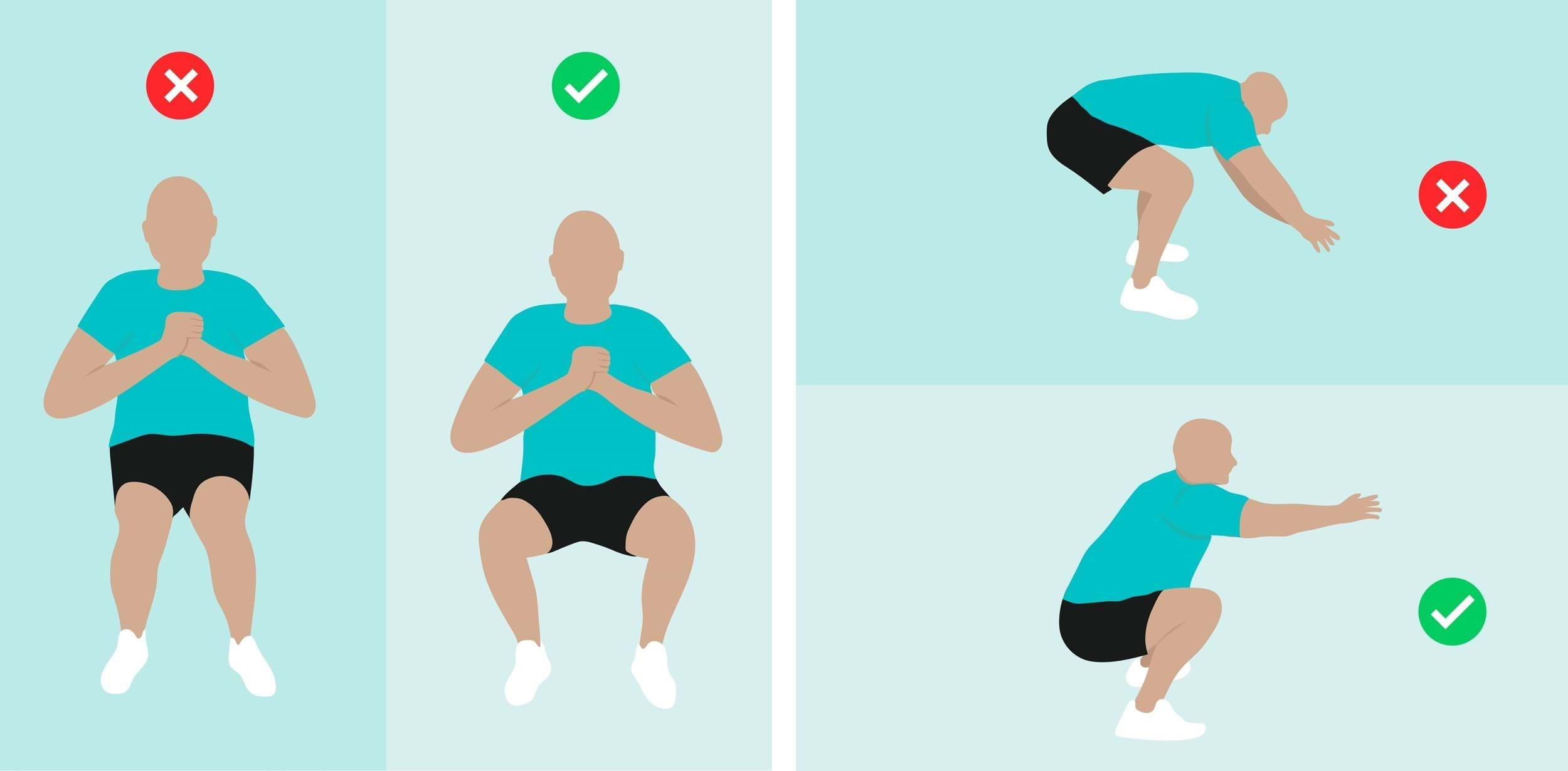
Push Ups
When asked how many push ups they could complete until failure, 1 in 3 people (32%) stated that they are unable to do any push ups at all. Just over half of the population (52%) are only able to complete a maximum of three push ups at a time, meanwhile 1 in 4 (24%) can complete 10 or more push ups in a minute.
When questioned on how comfortable they felt performing a push up, just under half (44%) stated that they didn't feel comfortable at all. More men (34%) are comfortable performing a push up than women (26%), but overall, almost a third of people aged below 34 years old state that they find the movement difficult to perform (30% of 16--24-year-olds and 29% of 25--34-year-olds).
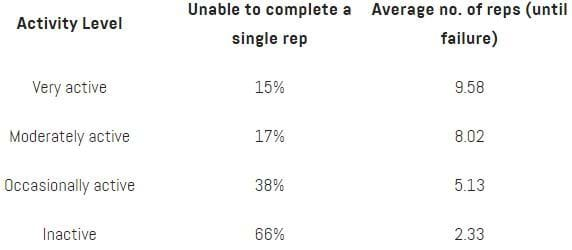
Table showing how many individuals that deem themselves very active, moderately active, occasionally active or inactive are unable to complete a push up, and the average number of reps for each
Common mistakes and how to avoid them:
- Often you see people attempt push ups with their elbows flaring out to the side but this is incorrect form. By keeping the elbows tighter towards your body, you engage the triceps effectively and reduce the risk of injury at the same time.
- Many of the issues you see with push ups come from having a weak core. If your stomach or hips are sagging, it means you're not bracing your core enough. Try moving your feet slightly wider to support the core, and if this still doesn't work then work on a push up on knees and try exercises like the plank until you have built up the strength needed to perform full push ups.
- Make sure you're using your full range of motion. If you're only doing part of the movement then you're not working your muscle groups effectively. It's better to do a push up on your knees with your full range of motion, than doing the full movement but only partially bending your arms.

How capable are we of performing basic cardio exercise?
Cardiovascular endurance refers to the ability to perform aerobic exercise for an extended period, with the heart and lungs delivering oxygen to the muscles being worked. Phil explains that "cardio, at all intensities, improves our heart and lung health. It can lower blood pressure, cholesterol and keep our arteries clear which reduces the risk of heart and circulatory diseases. Cardio also protects brain function, burns calories, and improves bone density."
We surveyed the nation to assess our levels of cardiovascular fitness by seeing how many could complete a 1.5 mile (2.41km) run, and in what time, and discovered that more than a third (38%) of the population wouldn't be able to. However, all is not lost when it comes to our cardiovascular fitness. On average, people can run 1.5 miles in just 12 minutes and 30 seconds, a speed classed as a 'good' time for anyone aged 20 or above.
There is still room for improvement though, with a quarter of the population (26%) stating that it takes them 13 minutes or longer to run 1.5 miles, which is classed as 'needing improvement' for those aged 20 or above. And it turns out over half of the population (50%) are uncomfortable with the idea of performing a 1.5-mile run, compared to just 24% who are happy to, with 1 in 3 people (36%) aged between 45-54 finding running 1.5 miles to be 'really uncomfortable', rising to over half of the 55+ population (52%).
Our cardiovascular fitness is important for more generic aspects of our daily lives too, with one of the most worrying statistics from the survey revealing that over half of the UK's population (55%) say that they get out of breath when walking up a flight of stairs, and just under half (47%) find it a struggle to walk a short distance, such as to their local shop. In fact, more than two thirds (70%) of people aged under 34 years old get out of breath when walking upstairs, and a huge 71% of people that describe themselves as inactive struggle with walking up a gradient (e.g. a hill).
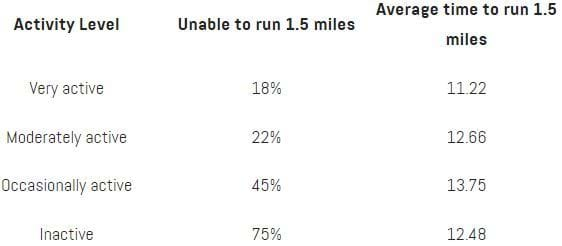
Table showing how many individuals that deem themselves very active, moderately active, occasionally active or inactive are unable to run 1.5 miles, and the average time it takes them
How good is our basic flexibility?
Flexibility essentially means the ability to move our joints through a wide range of motion, without pain or injury. A basic level of flexibility ultimately minimises the risk of injury, improves performance and increases muscle blood flow. Phil explains why this is so essential for our short term and long-term health, "flexibility or mobility is our body's secret superhero, one that we don't realise is there until we begin to lose it. When we have poor mobility, we feel tight, muscles and ligaments are more prone to strains and tears, and we lose our ability to perform daily tasks. The body will only compensate for poor mobility in one area for a certain amount of time before we begin to see full body issues."
We surveyed the nation to assess our levels of flexibility, by seeing how far people could reach when trying to touch their toes.
When asked how far they could reach, nearly 1 in 4 people (23%) stated that they can only get their fingertips to their sock line, or less, and less than half of the UK population (41%) can touch their toes at all. Impressively, more than 1 in 6 (16%) can impressively reach their toes with their wrist.
Being able to touch your wrist to your toes is benchmarked as a 'good' level of flexibility, and when looking at age splits within the UK those who can do this account for 21% of those aged 20 to 40 and 15% of those aged 41 to 60. Those who can only touch their sock line (benchmarked as 'improvement needed') account for 13% of those aged 20 to 40, and 23% of those aged 41 to 60.
Women tend to have greater flexibility than men, with more women (42%) stating that they feel comfortable touching their toes than men (33%). A quarter of people (25%) aged between 35 and 44 and a further 20% aged 34 or under, say they find the movement uncomfortable to perform. More worryingly, 76% of 16--24-year-olds say they struggle with poor flexibility -- which is well above the national average.
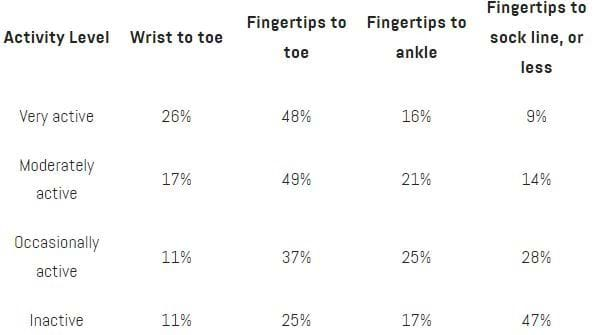
Table showing where individuals that deem themselves very active, moderately active, occasionally active can reach, when trying to touch their toes
Phil explains why our overall mobility seems to be an issue: "The average person spends most of their time laid or sat down. We wake up after a night of lying down, sit down to eat breakfast, drive to work, get a lift to the right floor, and sit at a desk until 5pm, often with lunch also spent at our desks. Then we drive home and spend the evening sitting in front of the TV."
Our Fitness Report revealed that 36% of people feel there simply isn't enough time in the day to stay active and work on their overall health, a sentiment that Phil agrees is contributing to a general lack of fitness, but also impacting our flexibility: "By the time the weekend comes around, the average person is exhausted, with a long list of chores like cleaning, food shopping, and simply recovering from the working week. Getting to the gym can seem impossible, and much less desirable than ordering a takeaway and relaxing.
Sedentary lifestyles have a huge impact on our mobility. When we do not use our muscles in the intended way, we lose range of motion and strength. Sitting down all day can cause tight hamstrings, weak hip flexors and glutes, weak upper back muscles, poor posture, and more.
Exercising can help alleviate these things, but a bigger culture change is also needed to properly address this. Having a manageable workload that means people have the energy to finish work and get to the gym is key and is something which starts in the workplace. Employers implementing and encouraging frequent breaks to get up and move around, the opportunity to participate in wellness classes like yoga and pilates, and even something as simple as being able to work from standing desks, would have a huge impact on mobility, mood, and even productivity."
How does this translate to our day-to-day mobility?
Having good general levels of flexibility is not just a nice-to-have; it can help make day to day tasks that bit easier and contributes to better range of motion in our bodies, helping us to avoid injury. Sadly, our study revealed that two thirds of the UK population (68%) struggle with stiff or tight muscles, and the majority also struggle with poor flexibility (69%), back pain/aches (71%) and feeling fatigued (72%). Furthermore, almost two thirds of people (64%) say they struggle with getting up from sitting on the floor, indicative of a lack of both leg strength and flexibility.
The Fitness Report also revealed that for those that don't feel they look after their health as much as they should, being too tired is the main reason (65%), with women (71%) more likely than men (59%) to experience regular fatigue issues. Our most recent findings have confirmed this, revealing that a huge 80% of people aged under 34 say they struggle with feeling fatigued -- a number that dips to a slightly below average 70% for anyone aged over 35.
Interestingly, more than half of the population struggles with recurring injuries such as muscle strains (59%), and it's the most active people who this impacts the most - 62% of very active people stating that they struggle with muscle strain. It's well known that poor flexibility can cause muscle strain, so this comes as no big surprise given that so many of us struggle with basic flexibility.
Phil advises anyone dealing with repetitive injuries, or stiff and tight muscles, to do the following:
- Look at strengthening exercises that improve mobility and flexibility, such as yoga, tai chi or Pilates
- Try bodyweight exercises or working with resistance bands to build strength before progressing to weighted exercises
- Fixed pin or fixed resistance machines are also a safe way to build strength before moving to free weights
- Always focus on correct form over amount lifted
- Work with a physio or PT to ensure injuries are not aggravated while strengthening
What exactly does all this mean for our health?
Phil believes that the results are not shocking, though they are saddening: "We have more evidence to support the mental and physical benefits of an active lifestyle than ever, but we're more sedentary than we ever have been.
New technology makes it easier to move less, we work more desk jobs, and we're increasingly busy, which can result in people staying at home and skipping working out to recover.
While there needs to be a balance, working out is one of the best things we can do for our mental health, even if it doesn't feel like it at the time, and prioritising our happiness should involve staying active."
Without making some changes, lacking a base level of fitness across our strength, cardiovascular endurance and mobility can have serious impacts on our health both now and in later life, increasing the risk of chronic diseases, like diabetes, heart disease, stroke and even cancer.
How can we improve our basic levels of fitness?
Phil suggests setting SMART goals and recording them for yourself. These are Specific, Measurable, Achievable, Relevant, and Time-Bound.
"It's better to start with small, sustainable changes and build on these. Something as simple as having a step goal or working out twice a week is a great place to start. Remember that lifestyle changes are just as, if not more, important, as working out. If you work out for 45 minutes a day but spend the rest of the day completely inactive, you're fighting a losing battle!
Everybody should be doing some form of physical activity every day. Whether this is walking, gardening or housework, to more vigorous exercise such as a gym workout or sports such as swimming or tennis. We need to raise our heart rates, within safe limits, at least twice a week to benefit from reducing the risk of chronic diseases and sickness."
Improving Strength
Building strength takes time and requires consistency in order to achieve the results that you want. One of the best ways to increase strength is to lift weights in the gym and then working each week to increase the weight, reps, or frequency, or shortening your rest time in between sets, to continually challenge the muscles.
Improving Endurance
Endurance relies on well-rounded workouts and a balanced diet. Try adding interval training into your workouts to increase your aerobic performance and endurance. It's also vital that your diet is working for you, not against you. Healthy carbohydrates along with staying hydrated are essential in increasing your endurance ability,especially during longer workouts.
Improving Cardio
Cardio workouts can be challenging so the best way to ensure consistency and success is to pick an activity you enjoy. Any aerobic exercise that uses your large muscles and makes your heart and lungs work harder will be ideal. Whether it's swimming, dancing, football, or even just taking the stairs or going for a walk while talking on the phone - raise that heart rate doing something that doesn't feel like work.
Improving Flexibility
Try sitting on the floor or in a deep squat, instead of on the sofa, or playing with with your pets or children on the floor. Standing up and moving every 1-2 hours that you are inactive during the day, plus stretching when you wake up or before you go to bed, can help to improve your flexibility without a lot of mental effort.
Improving Body Composition
We haven't looked at body composition in our study, but it's a vital part of our basic fitness too. It refers to the percentage of fat, muscle, bone, and water that makes up the body and can decrease the risk of diabetes, high blood pressure and heart disease, while making it much easier to perform exercises too. Monitoring your nutrition and maintaining regular exercise are the best ways to achieve a better body composition, ensure your caloric intake is in line with your body weight, and you're consuming enough fibre and protein - alongside weight training to help increase muscle mass.
Phil reminds us that "with regular exercise, you'll begin to see improvements in as little as four weeks, but it may take months to be able to do a push up, for example. Don't be disheartened! The goal is to stay active and improve fitness, regardless of how long it takes."
If you're struggling with any of the above, joining one of our strength, cardio or yoga/pilates classes could be a great way to kickstart your journey to better overall health. If you need any extra support, then hiring a personal trainer is another great way to keep yourself accountable and get that extra assistance to achieve your goals.
Methodology
PureGym partnered with Censuswide to survey 2,004 people aged 16+ in the UK.
105 social media videos (TikTok and Instagram) of people attempting to complete several basic movements (tricep dips, squats, slow squats, deep squats and push ups) were compiled and then critiqued by a PureGym Personal Trainer to reveal our common form errors.
Definitions:
Activity Level is defined as:
- Very active (30 mins exercise, 6-7 days per week)
- Moderately active (30 mins exercise, 3-5 days per week)
- Occasionally active (30 mins exercise, 1-2 days per week)
- Inactive (no activity per week)
Benchmarking
Results of the survey have been benchmarked against the following results, in order to label them as 'excellent', 'good', 'above average', 'average', 'below average', 'poor' and 'very poor'.
Tricep Dips
Twenties: 10 lifts
Thirties: 9 lifts
Forties: 8 lifts
Fifties: 7 lifts
Sixties: 6 lifts
Squats
Men:
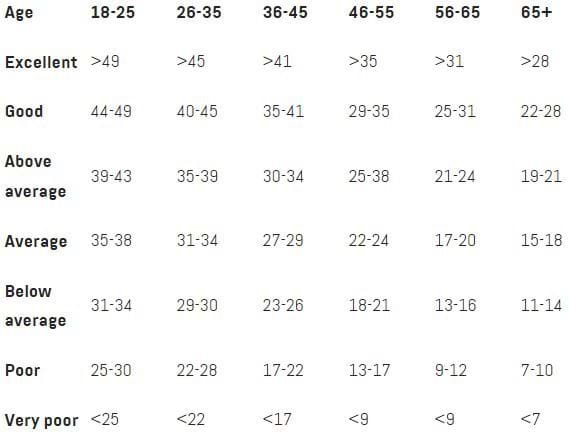
Women:
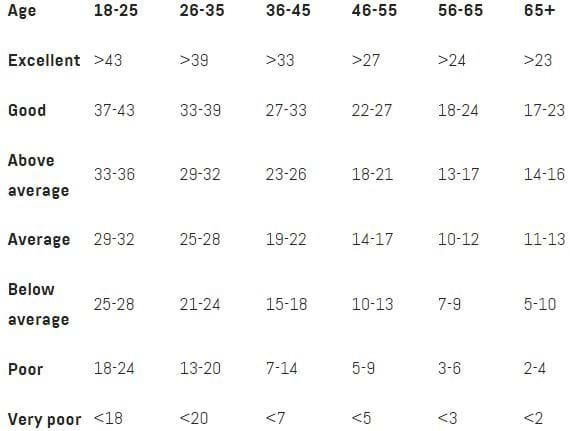
1 Minute Push Up Test
Men:
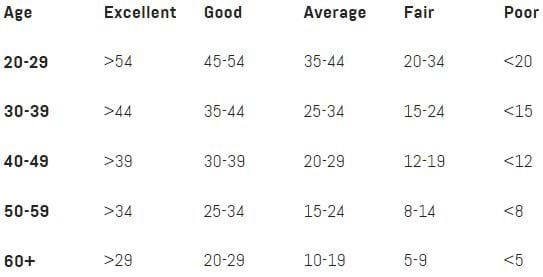
Women (modified push up):
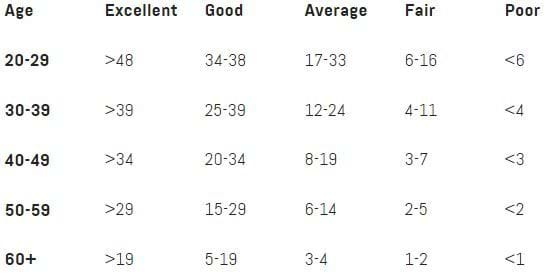
Cardio - 1.5-mile run
Results (in minutes:seconds)
Twenties:
Elite = faster than 8:13
Good = 8:14 to 12:51
Improvement needed = slower than 12:51
Thirties:
Elite = faster than 8:44
Good = 8:45 to 13:36
Improvement needed = slower than 13:36
Forties:
Elite = faster than 9:30
Good = 9:31 to 14:29
Improvement needed = slower than 14:29
Fifties:
Elite = faster than 10:40
Good = 10:41 to 15:26
Improvement needed = slower than 15:26
Sixties:
Elite = faster than 11:20
Good = 11:21 to 16:43
Improvement needed = slower than 16:43
Mobility - Toe touch
Average results:
Age 20 to 40
Wrist to toe = good
Fingertips to toe = average
Fingertips to ankle = fair
Fingertips to sock line = improvement needed
Age 41 to 60
Wrist to toe = good
Fingertips to toe = average
Fingertips to ankle = fair
Fingertips to sock line = improvement needed